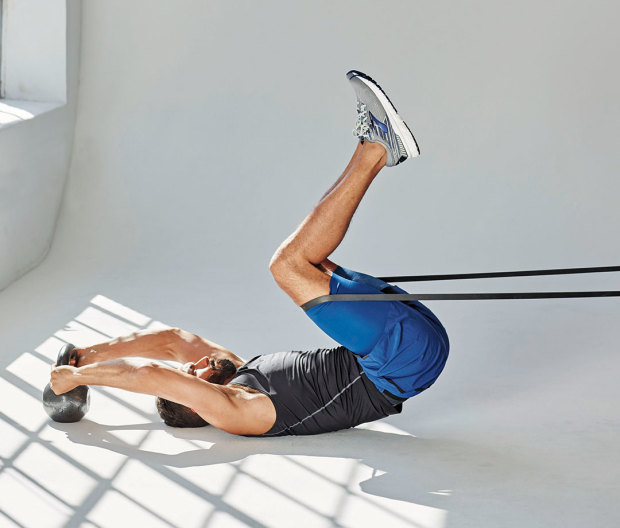We all want to feel great, stay healthy, build muscle, and stay lean—typically by keeping our midsections in check. Most people who are looking to reduce body fat and get in shape look at their stomach to see if they're making progress. It’s only natural. The coveted abdominals are the centerpiece of a guy's physique, so most guys at the gym make attaining a six-pack a high priority. In a nutshell, you need to do ab workouts with weights.
A note of trainer wisdom: Doing endless abs exercises will have literally no impact on your progress to burn fat and trim your waistline. Spot-reducing fat is a myth. Just because you work a body part hard in the gym does not mean fat will fall off and improve the appearance of just that body part.
And while nutritional intake will determine how lean you become and how your body will look, proper exercise is a critical component to improve overall health, performance, and aesthetics. In order to have a strong core and build muscle, you need to work the rectus abdominus regularly.
Just like any muscle group, once you remove the fat, you want the muscles to pop. By doing ab workouts with weights, you'll increase muscle and improve its appearance. Plus, strengthening your abdominals will help you during your lifts and other athletic events.
If you're just starting out, learn the basics with ab workouts for beginners, then progress to ab workouts with weights.
Can I Get a Six-Pack With Dumbbells?
You don’t necessarily need barbells, machines, or cardio equipment to get ripped. You can get a six-pack with just dumbbells and a bare-bones home-gym setup so long as it's combined with careful programming (e.g. weighted ab workouts). You’ll be able to easily add resistance to each core exercise and intensify your training for more hypertrophy. Because you’re moving weight with your arms while keeping your torso stable, you’ll attack your core from a variety of angles that are impossible to hit with traditional core exercises.
Should You Lift Heavy for Abs?
By performing weighted ab workouts, the core is being challenged constantly, negating the need for isolation work like crunches. For most lifters, this is welcome news.
Full-body workouts simulate a tough core routine, because these exercises challenge the core to stabilize the spine. During a heavy exercise, like a squat or deadlift, the weight puts a load on the spine. In order to protect you from injury, your abdominal muscles fire simultaneously to lock the spine into a neutral position. This contraction, referred to as an isometric contraction, can be extremely demanding, especially in exercises like a deadlift where core strength is imperative for proper form.
You don't want to completely forgo core-centric workouts and lower ab exercises, like Pilates, and exercises that focus on "anti-movement," like planks, side planks, and roll-outs. These bolster your core's main function: stabilization.
Try these 20 weighted abdominal exercises to sculpt a midsection worth showing off and strong enough to handle the heavy weights. You can mix and match to create loads of ab workouts with weights to keep your core guessing.
Resistance Band and Cable Abs Exercises
Justin Steele
Why It Works
During crunches, the top of the abdominals power the move, but the reverse crunch approaches the muscles from the other direction, so tension is greatest at the bottom.
How to Do It
- Attach a light resistance band to a rig or pole at shin height. Sit on the floor facing the attachment point, knees bent, the free end of the band across thighs, to start.
- Scooch back until the band is taut, then lie back and grasp a heavy kettlebell behind head to anchor the upper body.
- Draw belly in, lift lower back off the floor, and roll hips and knees toward shoulders, then reverse. That's 1 rep.
- Perform 2 to 3 sets of 15 to 20 reps.
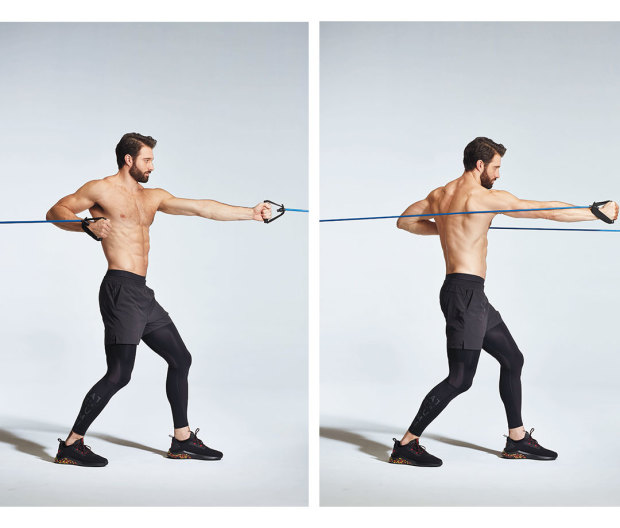
Justin Steele
Why It Works
Resistance band (or cable pulley) rows already require ab strength, but this particular push- pull motion transforms it into a 360-degree core move—which is great for bolstering the lower back.
How to Do It
- Anchor resistance bands on either side of you at chest height. Grab a handle in each hand, pivot to the left to face anchor, left arm outstretched, right arm bent, and knees soft, to start.
- Without rotating, simultaneously pull left hand back and press right hand forward, and reverse. That's 1 rep.
- Complete all reps on the left, then switch sides. Perform 2 to 4 x 8 reps.
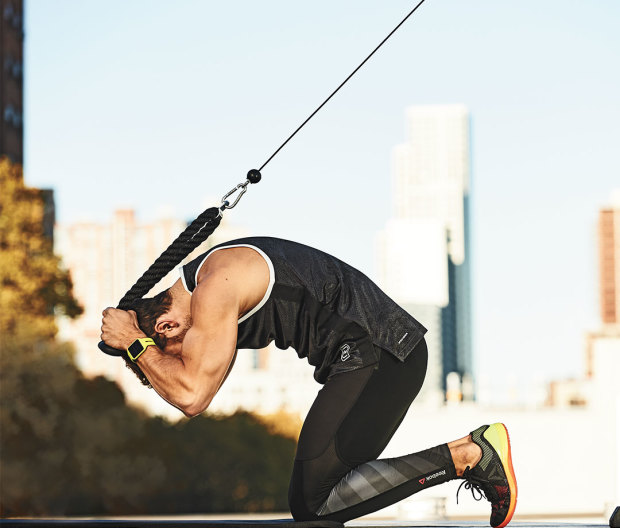
James Michelfelder
Why It Works
Because your abs are under constant tension, this is one of the most effective exercises to directly work your abs.
How to Do It
- Kneel in front of a high cable stack with a rope attachment and hold the rope with your hands on either side of your head, to start.
- Using your abs, not your arms, crunch forward while bringing your elbows toward your stomach.
- Slowly release to the start. That's 1 rep.
- Perform 3 x 12 to 15 reps.
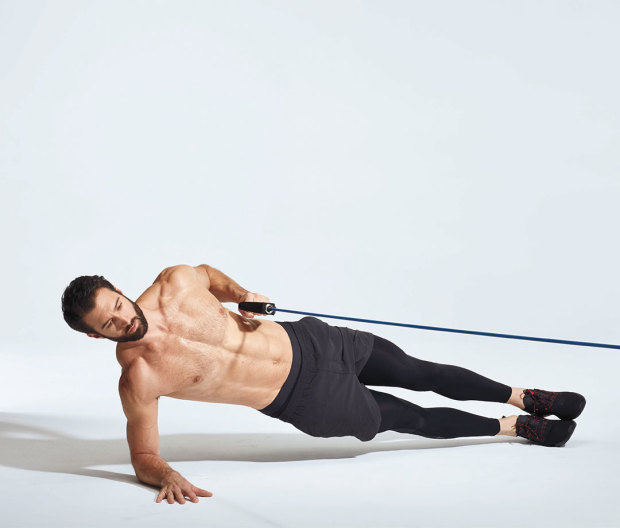
Justin Steele
Why It Works
Side planks are classic, and rows are de rigueur for shoulder and back strength. Fuse them for a total body challenge. The core—particularly the obliques—work hard to keep the body aligned. And the instability of the position causes smaller muscles in the chest to fire with each pull.
How to Do It
- Start in a right forearm-down side plank, feet stacked, left hand holding a resistance band anchored in front of body, to start.
- Pull left elbow back, then release with control. That's 1 rep.
- Do all reps on left side, then switch sides. Perform 3 x 8 to 10 reps.
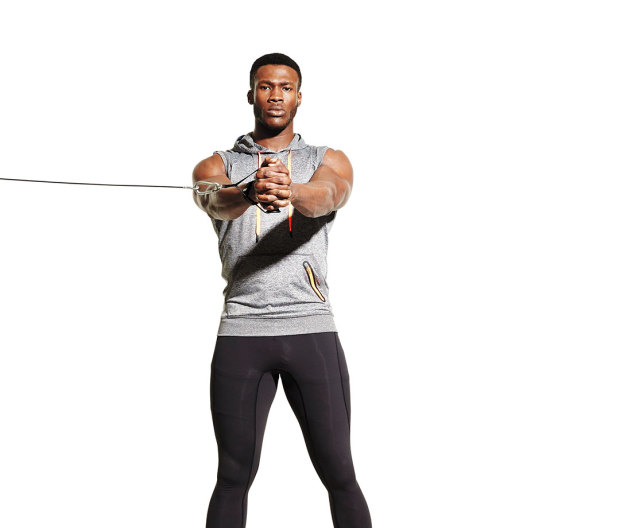
James Michelfelder and Therese Sommerseth
Why It Works
This is an anti-rotation exercise that improves core strength and stability since you're resisting load.
How to Do It
- Attach a band to a sturdy object at chest level (or use a D-handle on a cable station). Hold the other end with both hands and step away from the attachment point, turning your body perpendicular to it to put tension on the band, to start.
- Pull the band in front of your chest, then press it out with arms straight.
- Bend your arms and draw your hands back toward you, resisting the band from twisting your torso. That’s 1 rep.
- Perform 3 x 12 to 15 reps.
Barbell Abs Exercises
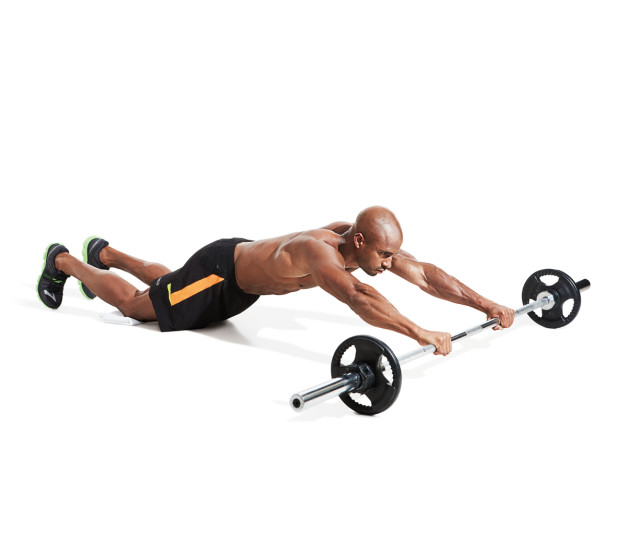
Why It Works:
Out of all the rollout variations, this one is our favorite. It taxes your abs quite a bit, and requires your core to be pretty strong without engaging your lower back. Try keeping your feet up—set your weight on your knees—so you don't cheat by pulling with your legs.
How to Do It
- Load 10-pound plates onto a bar and kneel behind it with your shoulders over the bar, to start.
- Brace your abs and roll the bar in front of you until you're about to collapse.
- Engage your core to roll back in to return to start. That's 1 rep.
- Perform 3 x 12 reps.
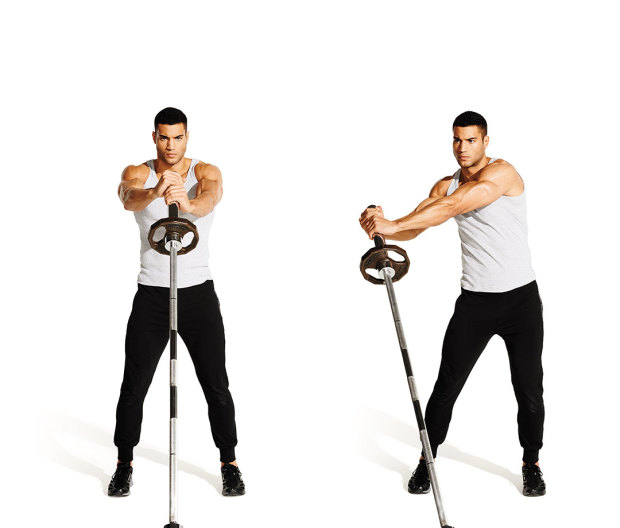
James Michelfelder
Why It Works
This exercise is a total abdominal-builder, but the oblique group is sure to take a beating as well. If you don't have a landmine apparatus with a handle, you can simply place a barbell in a corner of the room.
The key on this exercise is to NOT move the hips as you draw a half moon shape with the bar. Brace your whole body and do not move anything besides your arms as you perform the movement. To activate even more abdominal muscle fibers, brace your abs and exhale at the end of each rep.
How to Do It
- Load a bar in your gym’s landmine unit (or wedge the bar into a corner with a towel around the end to prevent slippage). Grasp the opposite end of the bar with both hands, with a stance that's perpendicular to the bar, your feet shoulder-width apart, and arms extended, to start.
- Using only your core and arms, draw a half-moon shape with the bar to the right, keeping your hips forward and feet planted.
- Return to center, then repeat on the left side. That's 1 rep.
- Perform 4 x 5 to 7 reps.
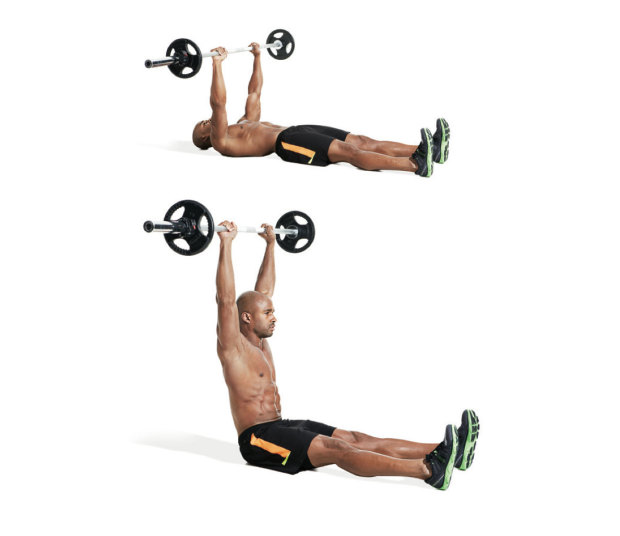
Why It Works
Compared with traditional bent-knee situps, straight-leg situps put less stress on your back, isolate your abdominal area, and disengage your hip flexors. Make sure not to rock or jump up fast—use your abdominals to get yourself up.
How to Do It
- Lie on the ground with legs extended, holding a barbell with light weight above your chest with arms straight, to start.
- As you sit up, raise the bar above your head, then lower slowly to the ground. That's 1 rep.
- Perform 3 x 10 reps.
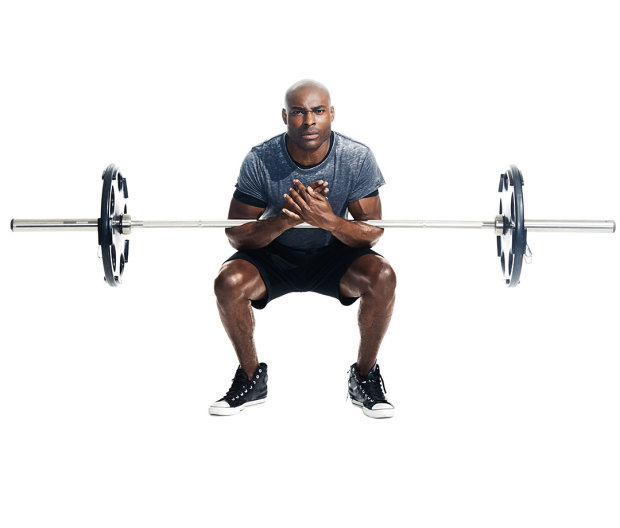
James Michelfelder & Therese Sommerseth
Why It Works
squat variation blasts your core like a Zercher squat. (Don’t be surprised if you feel it there more than in your legs.) Because you’re holding the weight right in front of your body, your core will work like crazy as you stay tall and avoid collapsing forward.
How to Do It
- Start with a barbell in the crook of your elbows, with your hands held together in front of your chest, to start.
- Stand shoulder-width apart with your toes slightly out.
- Squat down by sitting back, spreading your knees, and keeping your weight on your heels.
- Once your hips are below parallel, drive through your heels and rise. Keep your lower back flat and your shoulder blades squeezed together throughout. That's 1 rep.
- Perform 4 x 12 reps.
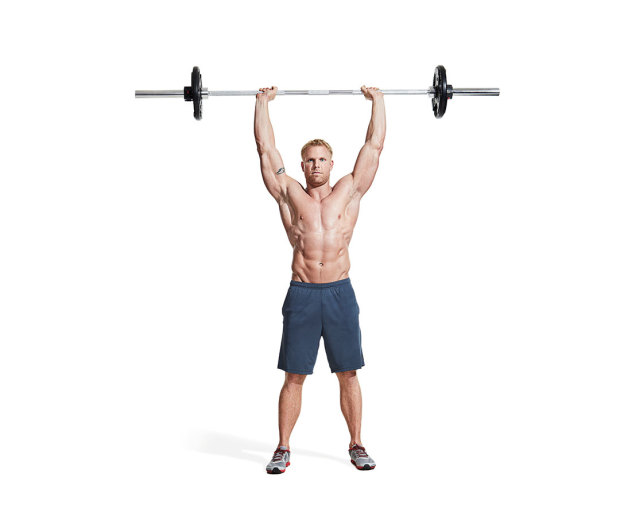
Beth Bischoff
Why It Works
Weight carries are a must-have exercise in any strength program. They build bulletproof conditioning as well as phenomenal core strength and endurance. The overhead carry amplifies the intensity on your abdominals and obliques because they have to fight to control a higher center-of-gravity.
How to Do It
- Place hands wider than shoulder-width apart and clean a barbell to your shoulders. Perform a push press to get the barbell overhead and hold, keeping elbows locked, to start.
- Take small steps forward. Don’t let your ribcage flare out or your low back arch excessively. If you get tired, slowly lower the weight to the floor or a squat rack.
- Perform 3 x 20 to 30m.
Free Weight Abs Exercises
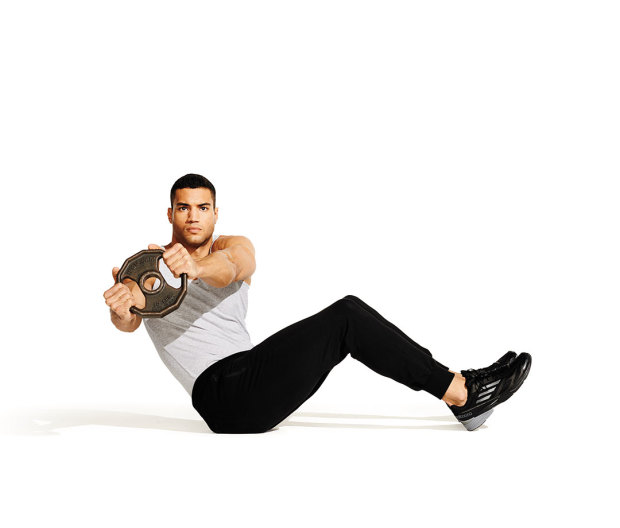
James Michelfelder
Why It Works
The Russian twist really challenges the transverse abdominis as well as the internal and external obliques. By holding a weight plate out in front of you, you decrease stability and up the intensity.
How to Do It
- Sit on the floor with knees bent 90 degrees holding a weight plate at chest, to start.
- Extend your arms in front of you, then lean back a bit so your torso is 45 degrees to the floor.
- Rotate your body as far as you can to the left, then to the right. That's 1 rep.
- Perform 3 x 8 to 12 reps.
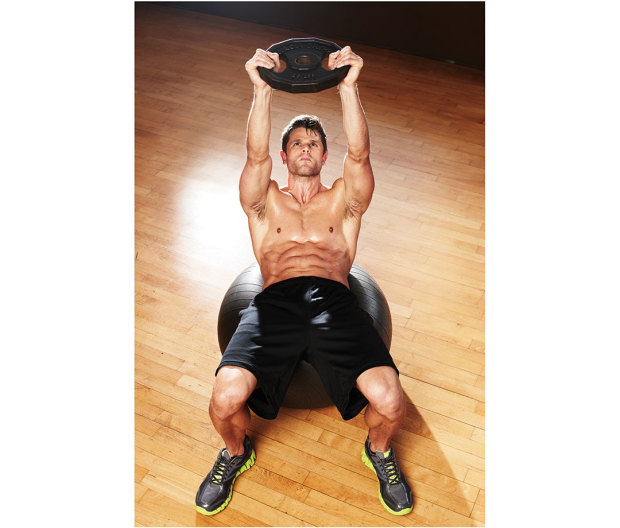
James Michelfelder and Therese Sommerset
Why It Works
This is a one-two punch for your abs. By lying on a Swiss ball, your core is constantly firing to maintain balance as you crunch a weight plate overhead.
How to Do It
- Hold a weight plate at arm’s length and rest your lower back on a Swiss ball, to start.
- Crunch your torso until you’re sitting upright, keeping the weight overhead at all times.
- Lower to the start position. That's 1 rep.
- Perform 3 x 10 to 15 reps.
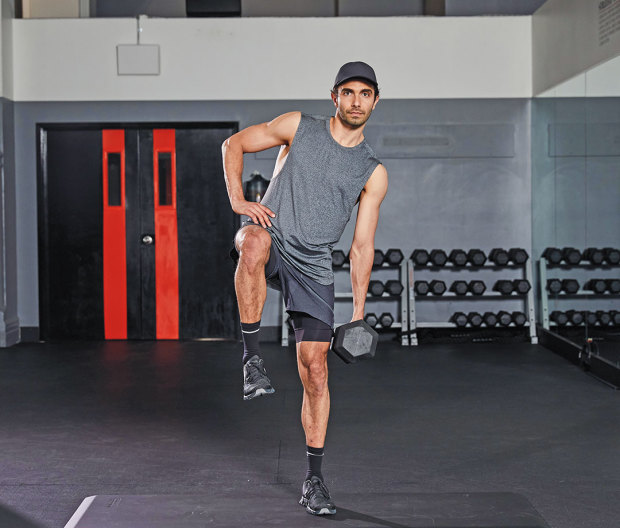
Marius Bugge
Why It Works
Any time you do a unilateral movement, your core is activated to keep you balanced. With this oblique dip variation, your internal and external obliques are strengthened. You're also working lateral flexion through the spine.
How to Do It
- Stand on left leg with right leg bent at 90 degrees, foot flexed, holding a dumbbell in left hand, to start.
- Keep obliques and glutes engaged as you dip toward the left. Power the movement entirely with your obliques. Slowly return to start. That's 1 rep.
- Do all reps on one side, then switch. Perform 3 x 10 reps each side.
- te: Stop immediately if you feel any pain in your spine. This exercise shouldn't have a huge range of motion.
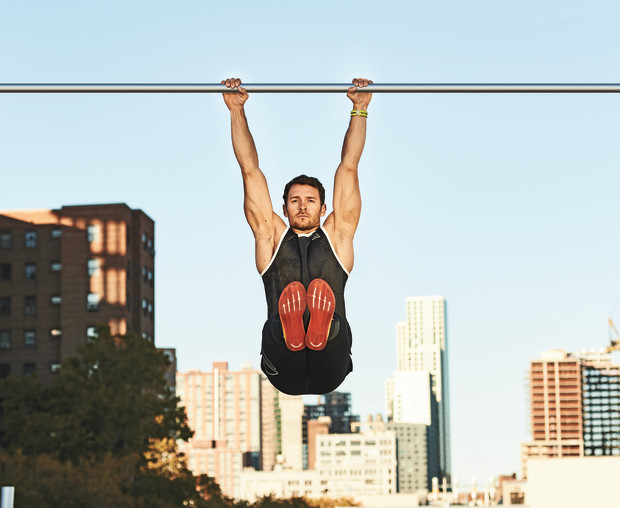
James Michelfelder
Why It Works
This gymnastic movement is an advanced version of traditional hanging leg raises. It utilizes the lats, core, hip flexors, biceps and smaller muscles in the back. This exercise requires the body to contract from a global extension (hanging hollow body position) to a global flexion (pike position). This tough exercise isn't for everyone, though. You must first master the hanging straight leg raise without any weight. Once you get strong enough, try doing sets with low reps and no kipping action.
How to Do It
- Grab a pullup bar and hang your body off the ground, gripping a small dumbbell with your feet, to start. (te: Photo demonstration illustrates bodyweight hanging leg raise.)
- Without rocking or swinging, raise your straight legs as high as you can.
- Lower back down under control. That's 1 rep.
- Add weight as you progress.
- Perform 3 x 5 reps.
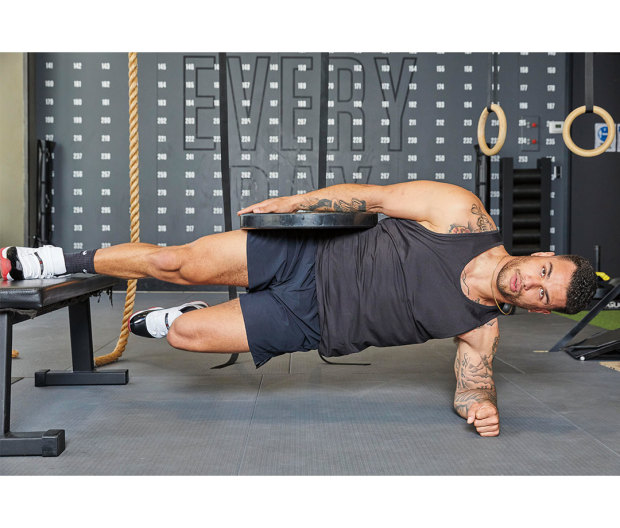
Marius Bugge
Why It Works
This is a more advanced exercise that works your hip and groin muscles, known as the abductors and adductors. This is also a great move to cook your core—specifically, the obliques.
How to Do It
- Position a bench or stool down by your feet. (You don’t want it to be too tall since you’re performing an elevated side plank from your forearm.) Lie on your left side, left forearm planted on floor inside of right foot resting on top of bench, to start.
- Hold a 25-pound weight plate or vest on the side of your top hip. Raise your body off the floor, supporting your weight with your right foot and left forearm.
- Alternate sides after each set. Perform 5 x 60 seconds each side.
- Make it harder by performing slow-tempo hip dips.
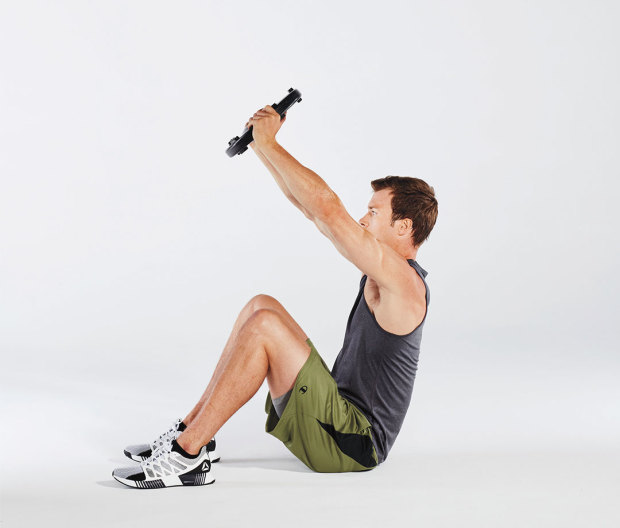
Justin Steele
Why It Works
Playing with plates has some unique advantages. You benefit from the increased finger strength that gripping flat weights requires, and holding the sides of plates positions your hands shoulder-width apart, which is great for activating your arms during overhead moves. Doing situps with a weight plate overhead is more challenging on your core since it's forced to counterbalance a load that's farther away from you.
How to Do It
- Lie down with knees bent, feet on the floor, and a 25-pound plate pressed toward the ceiling, to start.
- Lock out arms, retract shoulder blades, and engage core to perform a situp, pressing plate forward and out at the top of the movement.
- Reverse slowly until shoulders are on floor. That's 1 rep.
- Perform 3 x 10 reps.
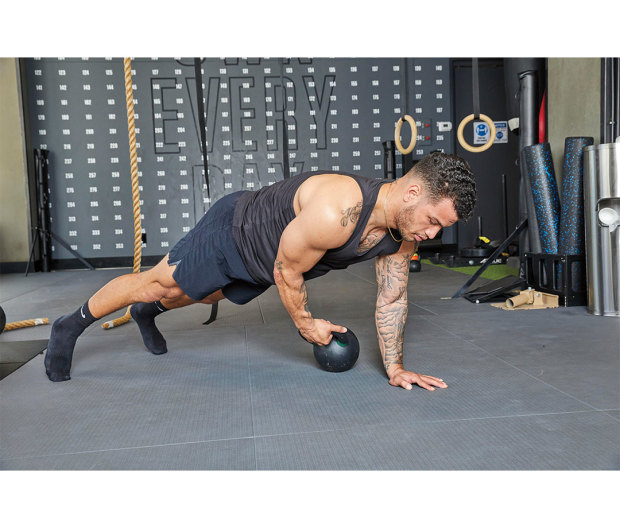
Marius Bugge
Why It Works
Aside from challenging your shoulders, kettlebell plank sweeps (aka pull-throughs and/or drags) train the entirety of your core. It's especially challenging on the obliques.
How to Do It
- Hold a high plank with a kettlebell just outside your left hand, to start.
- Reach under your torso to grab the kettlebell with your right hand and “sweep” or drag the KB back and forth with a full range of motion.
- Keep your core tight, glutes engaged, and hips level. Your obliques should power this exercise.
- Perform 4 x 60-second rounds.
Swiss Ball + Med Ball Abs Exercises
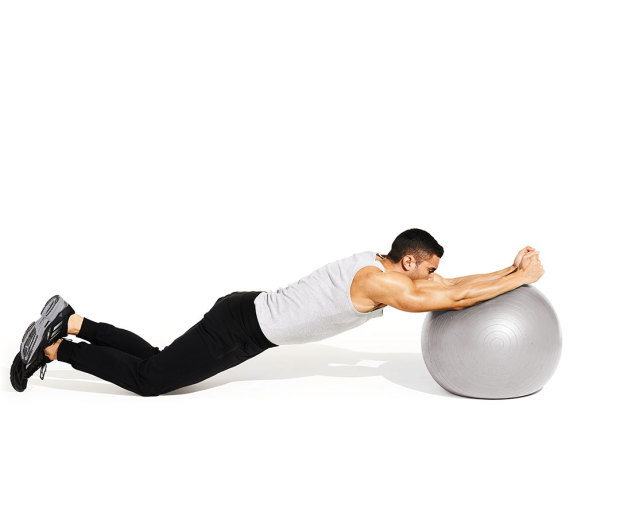
James Michelfelder
Why It Works
Despite using a stability ball, this rollout lights up your abs by creating a constant state of instability of tension. It hits the rectus abdominis, obliques, and muscles along the spine erector spinae.
How to Do It
- Kneel on the floor and rest your forearms on a Swiss ball positioned directly under your shoulders, to start.
- Roll the ball forward until you’re about to lose tension in your abs, pause, then roll back. That's 1 rep.
- Perform 3 x 10 to 12 reps.
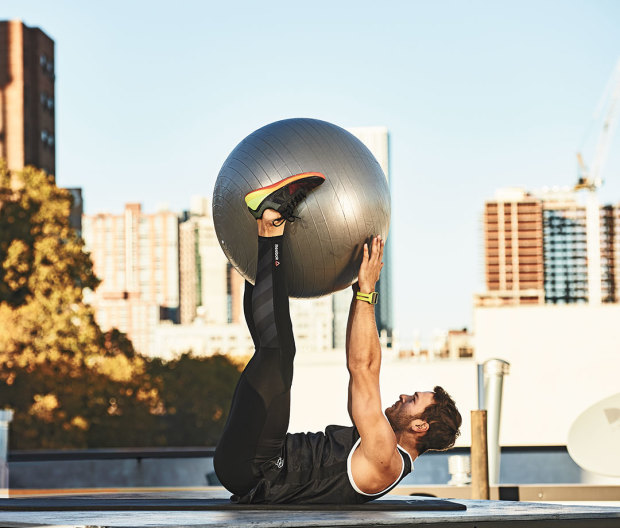
James Michelfelder
Why It Works
V-ups are challenging enough on their own as they require a fair amount of core strength and total-body coordination to get your upper and lower body in sync. By holding a Swiss ball between your feet, you light up the inner thighs and lower abs.
How to Do It
- Lie on the floor with arms extended overhead and legs straight in front of you while holding a Swiss ball with your feet, to start.
- Raise your upper body and your legs off the floor to form a V shape in the top position.
- Tap the Swiss ball, then slowly lower your torso and arms to the start position. That's 1 rep.
- Perform 3 x 12 to 15 reps.
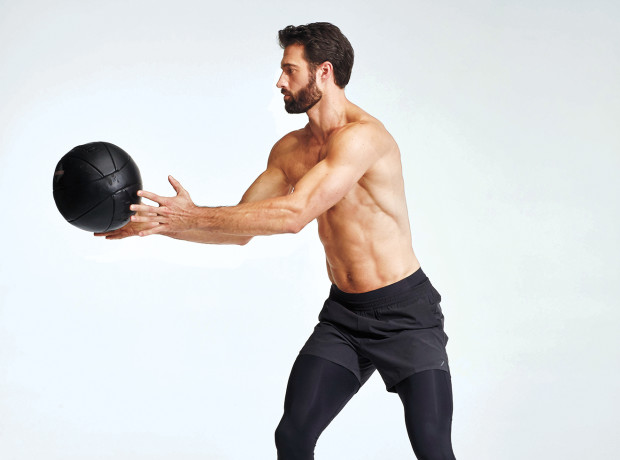
Why It Works
Rather than using the entire body (shoulders, arms, glutes, legs) to generate the power to move the ball, this move isolates the abs and hard-to-hit muscles like the serratus anterior (on the sides of your body).
How to Do It
- Stand with a wall to your right, about 3 feet away, holding a 10-pound medicine ball, to start.
- Keeping arms locked and reducing lower body rotation, toss ball at the wall and catch it. That's 1 rep.
- Do all reps on right side, then switch.
- Perform 4 x 8 to 10 reps.

